If you ever have the opportunity to enjoy a loaf made with freshly-ground flour, you’ll know the meaning of good bread. The experience is quite satisfying especially when you mill the flour yourself. Ron Nehrig takes that satisfaction up a notch by growing his own wheat and milling it into flour to make bread.
I met Ron a couple of years ago through the Artisan Bread Bakers group on Facebook. This virtual baking group hosts a diverse group of bakers from all around the world. I enjoy viewing the beautiful loaves made by bakers in the group, but when I started seeing photos of wheat growing, it caught my attention because I’m enamored with all things wheat and grains.
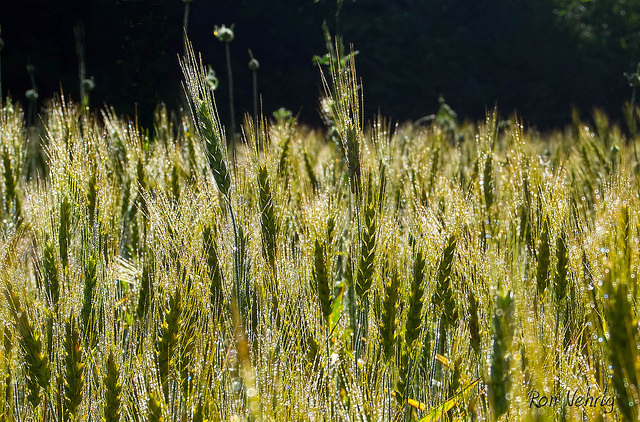
Hard Red Winter Wheat Covered in Dew
Photo by Ron Nehrig on Flickr https://www.flickr.com/photos/ronnehrig/sets
The person growing the wheat, of course, was Ron Nehrig. He’s a bread baker in his own right, but the thing that excited me about the activities he posted on FB was that he was living the bread experience – i.e. taking the wheat from the field to the table. I’ve always wanted to grow wheat so when I learned of another home baker growing wheat, I just had to find out more.
When photos of wheat and rye began appearing in my FB feed again this year, I decided it was time to catch up with the man who grows his own wheat, mills it into flour, and bakes delicious bread with it.
Ron graciously agreed to be featured on the Bread Experience, and he allowed me to use his gorgeous photos (one of his many talents). He also answered questions that reveal the man behind the wheat. I hope his story inspires you as much as it does me.
Interview with Ron Nehrig: Part 1 – Growing Grains
Part one focuses on growing wheat and other grains and part two is about milling grains for homemade bread.
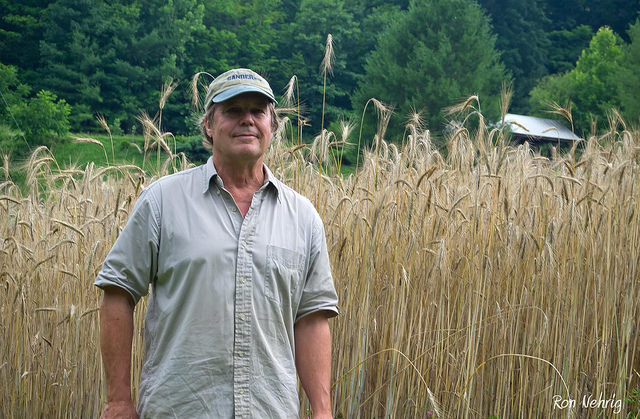
Ron in the Rye
Photo by Ron Nehrig on Flickr https://www.flickr.com/photos/ronnehrig/sets
Could you tell me a little bit about yourself?
I grew up on the south shore of Lake Michigan, swimming, boating, skiing, fishing, and generally enjoying the big empty natural spaces that the Great Lakes provide, and that instilled in me a love for large open spaces. So no matter what I do, or where I live, it is always in a thinly populated area where I can enjoy some quiet, the wild critters, and have room to grow things, which is currently in south central Indiana.
I like learning new things and new skills, exploring and photographing places that few people have ever seen, and making my own recipes for bread and other foods. I’ve traveled across the country many times on the smallest roads I could find–gravel, dirt, mud or sand, trails so overgrown in grass I had to look at the GPS to see where to drive, to experience the special places and creatures that hide out in difficult to reach areas. The rest of the time I’m a home body of sorts, and appreciate living in a low impact way on the environment. Since I grow some of my own food and recycle everything that can be, I create one bag of garbage in three or four months.
I studied philosophy, political science, economics, and did some graduate work in counseling therapy before deciding I didn’t want to do that. Since then I’ve built and sold custom furniture, restored large yachts in Florida, lived on a sailboat in Florida and the Bahamas for 4 years, written and sold computer software, and finally became an IT manager in a university department, which I did until I retired; nearly all of that time I lived in the country, heated with wood, and had a large garden.
I like to eat well, so I cook and grow a lot of my own food, to get better quality, and to minimize my exposure to the many contaminants introduced to our food supply, either accidentally or purposefully. I have spent a considerable time researching some pollutants (another story), and have seen enough of what is lurking in the foods we produce to know that I don’t want to eat them. It is very difficult to avoid these contaminants completely, but I can minimize my exposure.
I understand you built your current house. What led you to move to the country and build your own house?
Actually, this is the fifth house I’ve built; not because I like building houses all that much, and not to make a profit certainly, but because I prefer living in a house I’ve built myself, and feeling the connection that creates. I’ve always lived in the country, grown a large garden, and heated with wood… more connections, to the land and the Earth, but being retired gives me more time to grow things.
How did you get started growing wheat and how long have you been doing it?
I have baked bread for many years, mostly just simple functional bread, sandwich, French, dinner rolls or cornbread, but I didn’t start milling my own grains until around 2011, which is a bit of an oversight since I’ve grown Winter Wheat and Rye for many years as a winter ground cover for the garden. When I finally bought a grain mill it dawned on me to allow my Wheat and Rye ground covers to mature so I could harvest them as grain… a “Duh” moment!
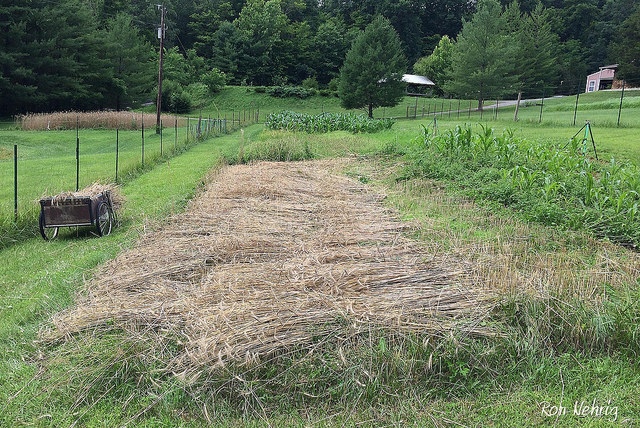
Rye Cut with a Modified Brush Cutter
Photo by Ron Nehrig on Flickr https://www.flickr.com/photos/ronnehrig/sets
Growing and harvesting grain built a connection with everyone, everywhere who ever stood in a field of grain in the July heat to cut and harvest the food that would be a very important part of their diet for the rest of the year. I love the expanded perceptions that new skills create.
What types of wheat (or grains) are you currently growing and when do you harvest them?
In my location I have had the best success with Hard Red Winter Wheat and Rye. I have tried small plots of Red and White Spring Wheat, Khorasan, and Oats, and they haven’t done well here. Spring planted grains sprout and grow together with the weeds, which makes harvesting more difficult, while fall planted grains begin growing in late fall, go dormant during the winter, then begin growing in very early spring when weeds are just thinking of sprouting, which gives winter Wheat and Rye a big advantage. I harvest Winter Wheat around the middle of June, with Rye a few weeks later. I also grow a number of varieties of corn for milling, including popcorn, which is easy to grow and dries well in the field. I use fresh milled corn flour in most of my breads; a small amount adds extra flavor and aroma, and, of course, fresh milled corn and wheat in corn bread is fantastic.
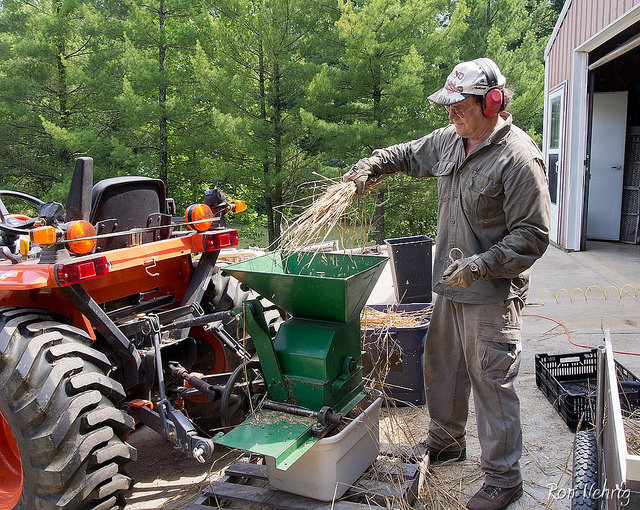
Threshing Wheat
Photo by Ron Nehrig on Flickr https://www.flickr.com/photos/ronnehrig/sets
How much wheat do you grow? Approximately how many loaves of bread can you make with it?
I don’t grow a lot of Red Wheat and Rye, because they are only two of the many grains I use. This year I harvested about 50 lbs of Hard Red Winter Wheat and about 40 pounds of Rye; together with the grains I don’t grow, this is enough to last the year. Last year my plots were larger and, if I remember correctly, I harvested around 100 lbs of Wheat, 75 lbs of Rye, and 50 lbs of corn. I still have some grain from my 2013 harvest, and quite a bit from 2014, so I cut back this year. 100 lbs of wheat is 100 lbs of flour, and that’s quite a bit of bread.
Do you sell any of the grains you grow/harvest or is this just for personal use/storage?
I don’t sell grains or bread, but I do have bread parties, and, for many years, took different breads to the Irish music sessions I played in, and to other social events. I like to share bread because very few people get to experience bread made from fresh milled grains–they really have no idea what good bread tastes like, and that some of those grains were grown in my garden just makes it more special.
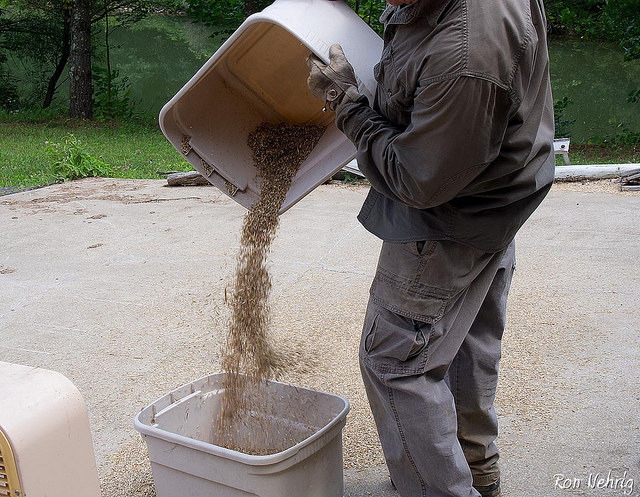
Winnowing Wheat
Photo by Ron Nehrig on Flickr https://www.flickr.com/photos/ronnehrig/sets
How long can you store the grains once they are harvested and dried?
Grain has been recovered from sealed jars stored in pyramids for thousands of years; it still sprouted and was viable. As long as the grain is sufficiently dried and sealed against bugs it will last many, many years, so I am careful to dry it completely before I seal it using re-usable food-quality silica gel containers, then adding an oxygen absorbing packet when I do seal it to prevent any bugs from growing.
What type of containers do you use to store the wheat? Where do you store it? Does it need to be kept at a certain temperature?
I store grain in food quality five gallon buckets, some with screw on lids with rubber gaskets for easy access, and some square ones that my purchased grain came in. My granary is a closet in a spare bedroom that I keep unheated in the winter so it is cooler than the rest of the house; in the summer it lives at air conditioner temperatures, so I figure the grain is fairly happy.
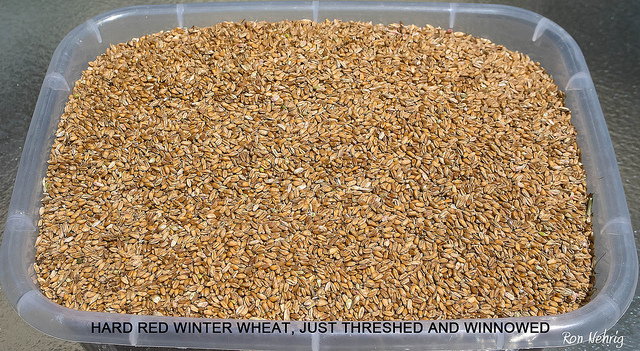
Photo by Ron Nehrig on Flickr https://www.flickr.com/photos/ronnehrig/sets
What advice do you have for other home bakers who would like to grow wheat on a small scale so they can use it to bake bread for their family and friends or perhaps sell it at a local farmer’s market?
Very small scale grain production is not efficient, much is done by hand with cobbled together tools; because of that I don’t see grain as a product that I would ever consider selling. I do have a small tractor with a six foot tiller, and have worked out a method to make planting fairly quick and efficient, though I don’t have a grain drill which would be the optimum. I’ve also developed a few tools to make harvesting easier, such as my gas powered brush cutter with the homemade grain cradle, and using my hammermill shredder for threshing, but compared to a combine these are labor intensive and crude.
For me the process is about the connection to history, to the land, to my food source and my bread, but not something I would do for money. With enough land to justify the price, storage and maintenance of a grain drill and a plot (very small) combine, selling grain might be feasible, but that isn’t a direction I will be taking.
Read Part Two of the interview with Ron to learn more about his garden and baking bread from home-milled grains.
For more information on growing and milling grains, refer to Ron’s article:
Growing Grain
A brief article on the process of Growing and Milling Grain.
Karen @ Karen's Kitchen Stories says
That is lovely!! Can’t wait to read the next installment!
Cathy says
Thanks Karen! Ron is definitely into some cool stuff!
courtney montgomery says
What a great article it was really very interesting.I can’t wait to read the next installment.